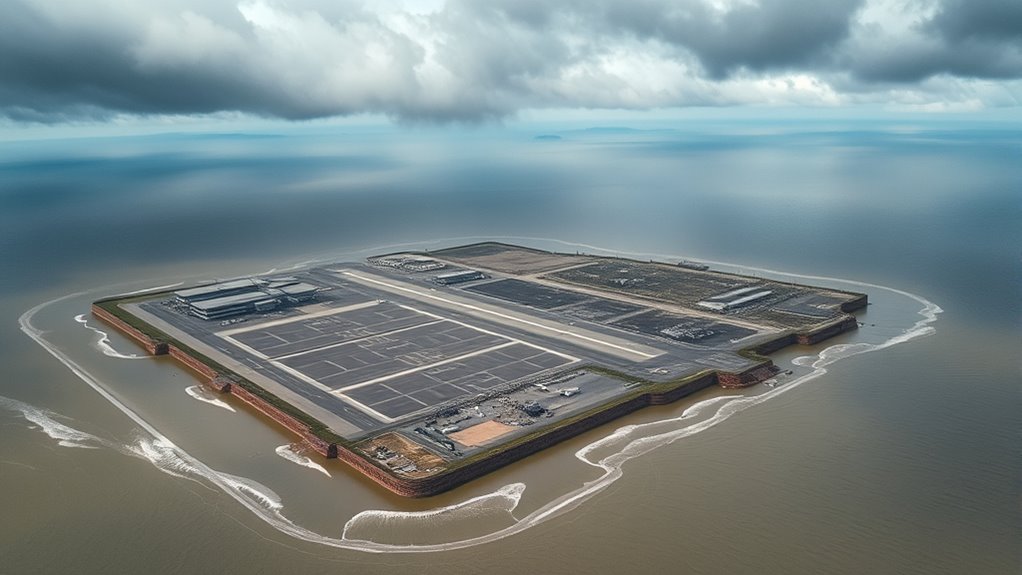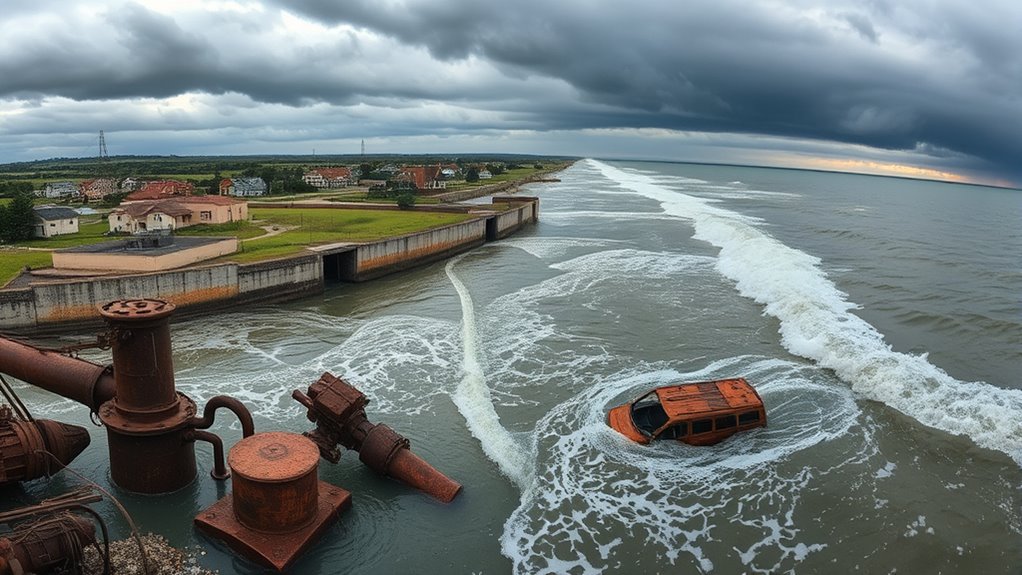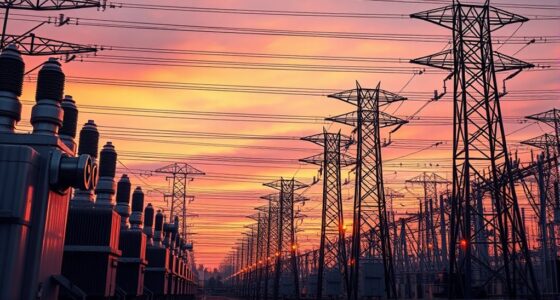Rising sea levels threaten your military bases by increasing flooding, erosion, and infrastructure damage, which can disrupt operations and weaken strategic advantages. Coastal facilities like runways, docks, and command centers are at risk of inundation, forcing costly upgrades or relocations. These environmental changes also heighten security concerns, making bases more vulnerable to threats. To understand how these risks could impact national security and what measures are being taken, keep exploring this urgent topic.
Key Takeaways
- Rising sea levels threaten to inundate coastal military bases, damaging infrastructure like runways, docks, and command centers.
- Coastal erosion could compromise base shoreline stability, risking access routes and essential operational facilities.
- Flooding and storm surge risks increase, potentially disrupting military readiness and mission capabilities.
- Environmental vulnerabilities may elevate security risks, including unauthorized access and espionage due to infrastructure damage.
- Proactive climate adaptation strategies are essential to preserve base functionality and strategic advantages through 2040.

As sea levels continue to rise due to climate change, U.S. military bases located along coastlines face increasing threats from flooding and erosion. These rising waters threaten not just infrastructure but also the strategic advantages these bases provide. To address these risks, you’ll need to consider climate adaptation strategies that bolster coastal security. Without proactive measures, military installations could become vulnerable to operational disruptions, damage, or even loss, compromising national security.
The challenge lies in implementing effective climate adaptation measures. You might be tasked with reinforcing existing structures or redesigning facilities to withstand higher water levels and severe weather events. Elevating critical infrastructure, installing flood barriers, and restoring natural buffers like wetlands are all steps that can help protect bases from inundation. These efforts aren’t just about physical defenses—they also involve planning for long-term resilience against unpredictable sea level rise. You’ll need to incorporate climate science data into your security planning, ensuring that infrastructure upgrades are aligned with projected sea level trajectories up to 2040. Recognizing the importance of climate science data can guide more effective planning and decision-making.
Coastal security becomes an even more significant concern as rising seas undermine the traditional protective barriers. Erosion can threaten runways, docks, and command centers, making access and operations more difficult. You might have to develop new strategies for shoreline stabilization or relocate vital facilities away from the most vulnerable zones. This proactive approach reduces the risk of operational interruptions and safeguards the integrity of military readiness. Recognizing the importance of coastal erosion prevention is essential for developing adaptive and sustainable solutions. Understanding sea level rise projections is crucial for developing accurate risk assessments and long-term adaptation strategies. Additionally, integrating vetted climate data from reliable sources can enhance the precision of your risk assessments.
Furthermore, climate adaptation isn’t solely about defending against natural elements; it also involves preparing for potential human threats exacerbated by environmental changes. As coastlines change, there’s an increased risk of unauthorized access or espionage, especially if infrastructure becomes compromised. Ensuring robust security protocols and cybersecurity measures are in place will be paramount to maintaining operational control. Incorporating security enhancements into your adaptation plans can further protect military assets from emerging environmental and human threats.
Ultimately, your goal should be to integrate climate adaptation into the core planning of military bases. This means not only protecting assets but also ensuring that bases remain operational, flexible, and secure in the face of a changing environment. By doing so, you safeguard the strategic advantages these bases provide and uphold national security in an era of rising seas. Staying ahead of these challenges requires continuous assessment, innovation, and commitment to coastal security, ensuring that your bases are resilient against the mounting threats posed by climate change.
Frequently Asked Questions
How Will Rising Sea Levels Impact Military Base Personnel Safety?
Rising sea levels threaten your safety at military bases by increasing coastal erosion, which can undermine structures and cause flooding. You might face evacuations or hazardous conditions if infrastructure resilience isn’t improved. As sea levels rise, it’s vital that measures are taken to protect personnel, ensuring safe access and operations. Without proactive steps, your safety could be compromised by the growing risks from climate change-induced coastal vulnerabilities.
Are There Plans to Relocate Vulnerable Military Bases?
You might wonder if there are plans for base relocation. The military is actively working on infrastructure resilience, identifying vulnerable bases, and considering relocation to safer areas. These efforts aim to protect personnel and critical operations. By prioritizing base relocation and strengthening infrastructure, the military seeks to adapt to rising sea levels and ensure long-term operational security. This proactive approach helps mitigate risks posed by climate change.
What Cost Estimates Exist for Base Flood Defenses?
You might worry about the cost of protecting bases, but a thorough cost analysis helps prioritize infrastructure investments effectively. Estimates for flood defenses vary widely, often running into hundreds of millions or even billions of dollars per site. While these expenses are high, many defense planners view them as essential investments to safeguard critical assets and national security. Planning now guarantees you’re prepared for future challenges posed by rising sea levels.
How Will Rising Seas Influence Military Training Exercises?
Rising seas will force you to adapt your military training exercises to address sea level adaptation and coastal erosion. You’ll need to modify training locations that are vulnerable to flooding and erosion, ensuring safety and operational readiness. Coastal erosion can threaten infrastructure, requiring you to implement protective measures. By proactively adjusting your strategies and facilities, you can maintain effective training while safeguarding assets against the effects of rising sea levels.
Could Climate Change Exacerbate Geopolitical Tensions Around Bases?
You might not realize it, but climate change could intensify geopolitical tensions around bases. Rising sea levels threaten strategic locations, prompting nations to engage in climate diplomacy to secure resources and protect assets. As water conflicts grow, resource disputes may escalate, fueling regional instability. This increased competition could strain alliances and complicate military cooperation, making climate change a critical factor in future geopolitical and resource conflicts.
Conclusion
You should realize that ignoring rising sea levels risks devastating your military infrastructure. By 2040, many bases could face flooding, disrupting national security. Remember, a chain is only as strong as its weakest link—protecting these bases is essential. Taking proactive steps now can prevent future chaos. If you fail to act, the cost could be far greater than you imagine. Adapt and prepare, because in the face of change, resilience is your best defense.
Amina brings over a decade of journalism experience to her role as Editor-in-Chief. Under her leadership, Exquisite Post has flourished, maintaining the highest standards of integrity and excellence. Amina’s commitment to truth and her visionary approach guide the editorial team in producing impactful news stories that resonate with our audience.










